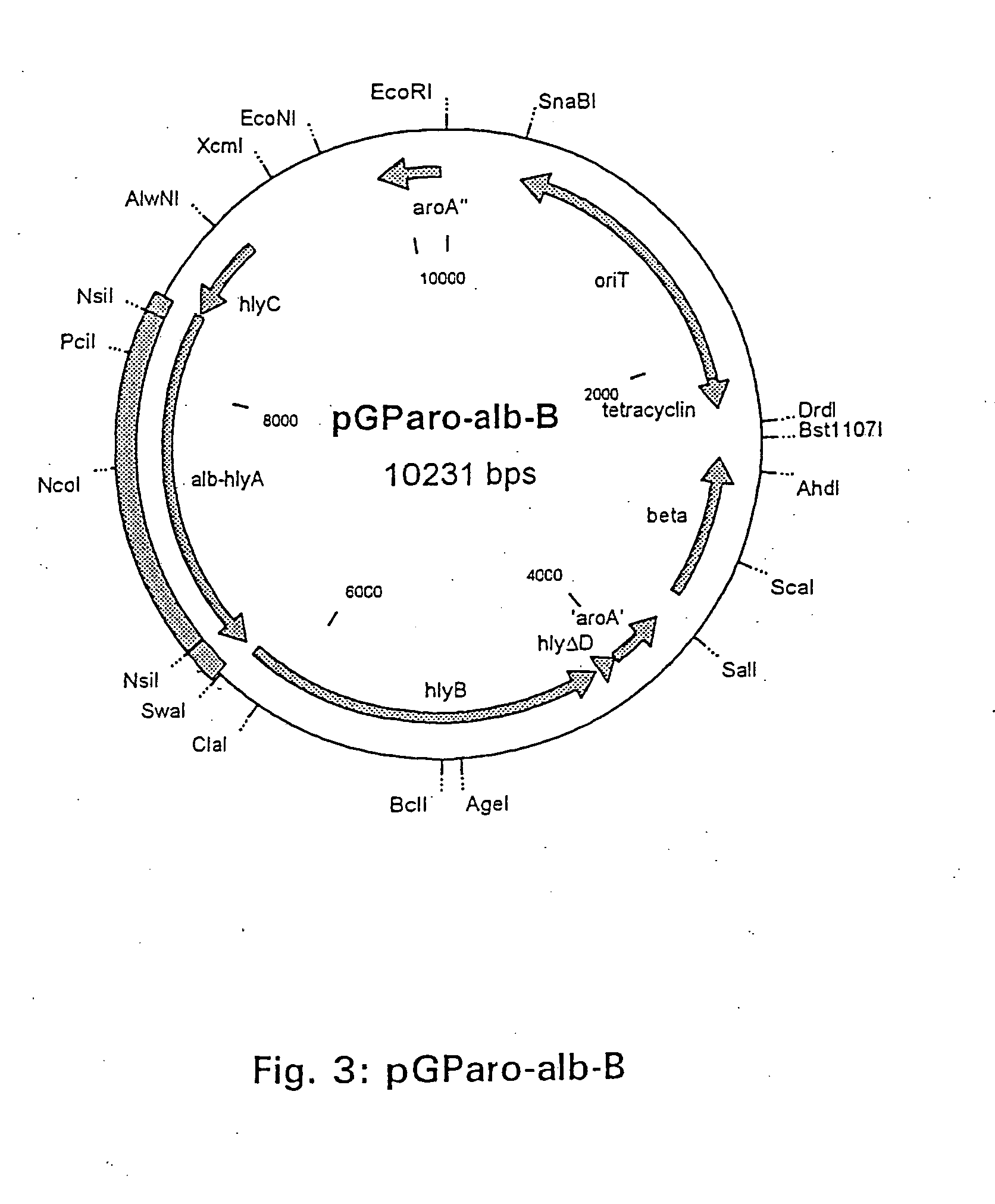Enveloped miroorganism
a miroorganism and microorganism technology, applied in the field of microorganisms, can solve the problems of not being fully known, unreachable up to now, poor tumor therapy success, etc., and achieve the effect of increasing the effectiveness of treatmen
- Summary
- Abstract
- Description
- Claims
- Application Information
AI Technical Summary
Benefits of technology
Problems solved by technology
Method used
Image
Examples
example 1
Construction of a Bacteria Strain for the Membrane-Bound Expression of Human Albumin and Beta-glucuronidase
[0036] In this example, the way to the bacteria strain St21-bglu is described. This attenuated Salmonella typhi Ty21a strain (carrier approved for human use) expresses by means of the hly secretion machinery of E. coli membrane-bound fusion proteins of human beta-glucuronidase and hlyA and human albumin and hlyA. The construction is based on the already published plasmids pMOhlyl (Gentschev et al., Behring Inst. Mitt. 57-66, 1994) and pGP704 (Miller and Mekalanos, J. Bacteriol. 170:2575-2583, 1988). The strain permits by passive targeting (Bermudes et al., Adv. Exp. Med. Biol. 465:57-63, 2000) an enrichment of beta-glucuronidase at the tumor and thus a fission restricted to the tumor tissue of prodrugs to be activated by beta-glucuronidase.
[0037] A membrane-bound expression can take place in salmonellae by fusion of the protein to the C-terminus of the hlyA secretion protein ...
example 2
Construction of a Bacteria Strain Enveloped with Albumin-hlyA Fusion for Supplying the Genetic Information of Human Beta-glucuronidase.
[0042] The bacteria strain described in this example is intended to supply by means of the passive targeting DNA that encodes human beta-glucuronidase for tumor cells, which are then to be expressed in the tumor cells. In order to obtain a strain being particularly easy to handle, in this example a slightly modified strain as in Example 1 is used for the membrane expression of albumin. The gene that encodes albumin-hlyA as well as the information for hlyB is to be chromosomally integrated. Thereby, this strain expresses constitutively membrane-bound albumin.
[0043] For this purpose, the vector pMOhly alb described above is digested by BsrBI and EcoRI and then treated with 5′-3′ exonuclease. This digestion produces a 5,815 bps fragment with blunt ends containing the complete prokaryontic activation sequence and the genes hlyC, alb-hlyA and hlyB, not ...
example 3
Construction of a Strain Enveloped with Albumin-TolC Fusion with Membrane-Bound Expression of the Extra-Cellular Domain of fas and Supply of an Enzyme Converting Prodrug
[0046] The strain shown in this example unites the features shown in Example 2 with a specific targeting at (tumor) cells expressing fas ligand (fasL). It is possible, with this strain, to specifically attack fasL-expressing tumor cells, such as in certain breast tumors (Herrnring et al., Histochem. Cell. Biol. 113:189-194, 2000). fasL expression by tumor cells was postulated as a potential mechanism for immune escape, since these cells can eliminate actively attacking, fas-expressing lymphocytes (Muschen et al., J. Mol. Med. 78:312-325, 2000). With the strain shown here, these tumor cells being very problematic for a therapy can specifically be attacked and then eliminated by an apoptosis-independent mechanism. The carrier strain is based in this example on a fusion of albumin with the TolC protein of E. coli. Ther...
PUM
| Property | Measurement | Unit |
|---|---|---|
| Composition | aaaaa | aaaaa |
Abstract
Description
Claims
Application Information
 Login to View More
Login to View More - R&D Engineer
- R&D Manager
- IP Professional
- Industry Leading Data Capabilities
- Powerful AI technology
- Patent DNA Extraction
Browse by: Latest US Patents, China's latest patents, Technical Efficacy Thesaurus, Application Domain, Technology Topic, Popular Technical Reports.
© 2024 PatSnap. All rights reserved.Legal|Privacy policy|Modern Slavery Act Transparency Statement|Sitemap|About US| Contact US: help@patsnap.com










